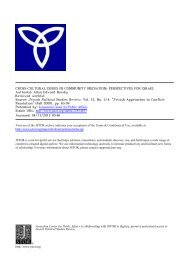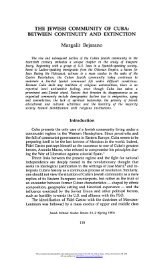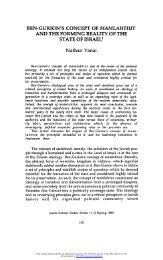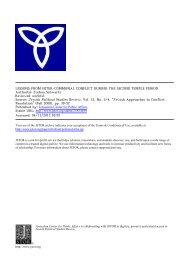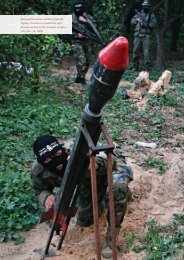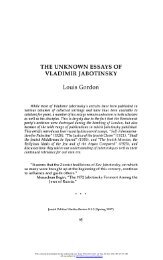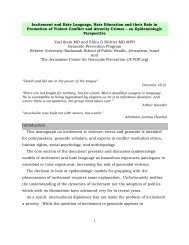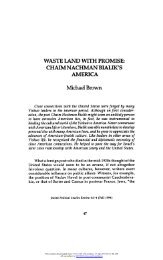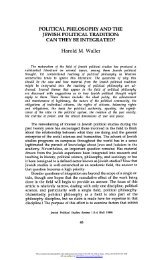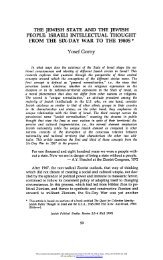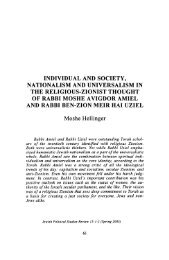Linking the Gaza Strip with the West Bank: - Jerusalem Center For ...
Linking the Gaza Strip with the West Bank: - Jerusalem Center For ...
Linking the Gaza Strip with the West Bank: - Jerusalem Center For ...
Create successful ePaper yourself
Turn your PDF publications into a flip-book with our unique Google optimized e-Paper software.
page 32it is <strong>the</strong>refore suggested that initially <strong>the</strong> convoys shouldbe smaller than fifteen trucks, so as to minimize waitingtime. 179 Indeed, initially <strong>the</strong> convoys could be madeavailable to well established trucking companies only,and pre-cleared drivers. From this it could eventuallybe expanded to all trucking companies and drivers. 180With such an expansion <strong>the</strong>re should be an advancedreservation system, where to make a reservation onewould have to provide information about <strong>the</strong> driver,vehicle, and cargo aboard. 181 This too could minimizedelays and waiting time.Once bus convoys are operational, convoys usingPalestinian passenger vehicles can be introduced. Thesepose <strong>the</strong> greatest security challenge, as each vehicle willhave to undergo a security check. As <strong>with</strong> bus convoys,<strong>the</strong> security aspect of passenger vehicle convoys shouldbe managed by a private Israeli security firm, which couldei<strong>the</strong>r simply check <strong>the</strong> convoys, or could both check andescort <strong>the</strong> convoys.Such a system is reminiscent of a recommendation of <strong>the</strong>1937 (British Mandatory Government) Peel Commission,which suggested <strong>the</strong> partition of mandatory Palestineinto two states -- a Palestinian Arab State and a JewishState. Under this recommendation, <strong>the</strong> Jewish Statewould have been non-contiguous. Therefore <strong>the</strong> PeelCommission recommended some sort of travel corridorthat would connect <strong>the</strong> parts of <strong>the</strong> Jewish State. TheCommission asserted that an open travel corridor “wouldalso solve <strong>the</strong> problem, sometimes said to be insoluble,created by <strong>the</strong> contiguity of Jaffa <strong>with</strong> Tel Aviv to <strong>the</strong> northand <strong>the</strong> nascent Jewish town to <strong>the</strong> south. If necessary,Mandatory police could be stationed on this belt. Thisarrangement may seem artificial, but it is clearlypracticable.” 182 This arrangement, even if artificial, wasaccepted by <strong>the</strong> Jewish Agency but rejected by <strong>the</strong> Arabswho did not want a ‘Jewish passage’ running through<strong>the</strong>ir territory. Some such similar arrangement could in<strong>the</strong> future be required of Israel.Vehicle clearance will involve two stages. The first willbe concerned <strong>with</strong> <strong>the</strong> roadworthiness of <strong>the</strong> vehicle,and whe<strong>the</strong>r <strong>the</strong> vehicle meets Israeli vehicle and safetyrequirements. Once a vehicle passes through this stage,<strong>the</strong>re will also be a physical security check. Only uponcompletion of both stages will a car be allowed to use<strong>the</strong> passage. 184The actual form that <strong>the</strong> passage will take is a technicalpoint. Some argue that it should take <strong>the</strong> form of atunnel, o<strong>the</strong>rs an ordinary highway, o<strong>the</strong>rs an elevatedhighway, and yet o<strong>the</strong>rs a railroad. Whatever form <strong>the</strong>passage takes will likely depend on Israel’s securityconsiderations and <strong>the</strong> financial costs. The question ofunder whose sovereignty <strong>the</strong> mode of passage will fall isan essential consideration.E. Questions of Safe Passage1. SovereigntyIn spatial terms international law recognizes four typesof territorial regime. These are territorial sovereignty,territory that is not subject to <strong>the</strong> sovereignty of anystate or states and has a status of its own (for example,mandated territories), res nullius (territory that issusceptible to acquisition by states but over which noone as yet has sovereignty or control) and res communis(communal land belonging to <strong>the</strong> world population andnot capable of being placed under state sovereignty; forexample, <strong>the</strong> seas and outer space). 185 It is <strong>with</strong> territorialsovereignty that we are concerned.Territorial sovereignty is not only used as a descriptionof <strong>the</strong> legal personality of <strong>the</strong> state. It is also used as areference to <strong>the</strong> normal complement of rights that attachto <strong>the</strong> state -- a state’s legal competence. These rightsare indefeasible except by special consent of <strong>the</strong> stateconcerned. 186 Thus, Professor Brierly defined territorialsovereignty not in terms of <strong>the</strong> independence of <strong>the</strong> state,but ra<strong>the</strong>r in terms of <strong>the</strong> existence of plenary rightsover a state’s territory. 187 Such rights apply primarily<strong>with</strong> respect to <strong>the</strong> state’s landed territory, but also to<strong>the</strong> sea adjacent to <strong>the</strong> land and <strong>the</strong> seabed and subsoilof <strong>the</strong> territorial sea. 188



